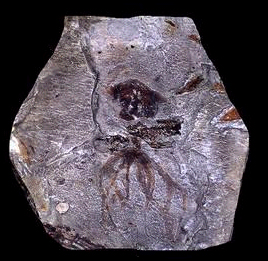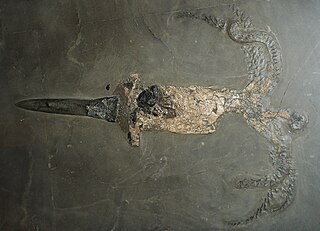
Ammonoids are a group of extinct marine mollusc animals in the subclass Ammonoidea of the class Cephalopoda. These molluscs, commonly referred to as ammonites, are more closely related to living coleoids than they are to shelled nautiloids such as the living Nautilus species. The earliest ammonites appeared during the Devonian, with the last species vanishing during the Cretaceous–Paleogene extinction event.

Belemnoids are an extinct group of marine cephalopod, very similar in many ways to the modern squid and closely related to the modern cuttlefish. Like them, the belemnoids possessed an ink sac, but, unlike the squid, they possessed ten arms of roughly equal length, and no tentacles. The name "belemnoid" comes from the Greek word βέλεμνον, belemnon meaning "a dart or arrow" and the Greek word είδος, eidos meaning "form".

Cirrina or Cirrata is a suborder and one of the two main divisions of octopuses. Cirrate octopuses have a small, internal shell and two fins on their head, while their sister suborder Incirrina has neither. The fins of cirrate octopods are associated with a unique cartilage-like shell in a shell sac. In cross-section, the fins have distinct proximal and distal regions, both of which are covered by a thin surface sheath of muscle.

Protosphyraena is a fossil genus of swordfish-like marine fish, that thrived worldwide during the Upper Cretaceous Period (Coniacian-Maastrichtian). Though fossil remains of this taxon have been found in both Europe and Asia, it is perhaps best known from the Smoky Hill Member of the Niobrara Chalk Formation of Kansas. Protosphyraena was a large fish, averaging 2–3 metres in length. Protosphyraena shared the Cretaceous oceans with aquatic reptiles, such as mosasaurs and plesiosaurs, as well as with many other species of extinct predatory fish. The name Protosphyraena is a combination of the Greek word protos ("early") plus Sphyraena, the genus name for barracuda, as paleontologists initially mistook Protosphyraena for an ancestral barracuda. Recent research shows that the genus Protosphyraena is not at all related to the true swordfish-family Xiphiidae, but belongs to the extinct family Pachycormidae.

Protostega is an extinct genus of sea turtle containing a single species, Protostega gigas. Its fossil remains have been found in the Smoky Hill Chalk formation of western Kansas, time-equivalent beds of the Mooreville Chalk Formation of Alabama and Campanian beds of the Rybushka Formation. Fossil specimens of this species were first collected in 1871, and named by Edward Drinker Cope in 1872. With a total length of 3.9 metres (13 ft), it is the second-largest sea turtle that ever lived, second only to the giant Archelon, and one of the three largest turtle of all time along Archelon and Gigantatypus.

Incirrata is a suborder of the order Octopoda. The suborder contains the classic "benthic octopuses," as well as many pelagic octopus families, including the paper nautiluses. The incirrate octopuses are distinguished from the cirrate octopuses by the absence in the former of the "cirri" filaments for which the cirrates are named, as well as by the lack of paired swimming fins on the head, and lack of a small internal shell.

Palaeoctopus newboldi is an extinct basal octopod that lived in the Late Cretaceous, approximately 89 to 71 million years ago. Fossil material assigned to this species originates from the Mount Hajoula region in Lebanon. The holotype was found below the Old Covent, Sahel-el-Alma, Mount Lebanon and is deposited at the Natural History Museum in London. It might belong to the Cirrina or be more basal in the Octopoda. Specimens from the Turonian of Vallecino, Mexico, originally described as P. pelagicus, are reinterpreted to be portions of a coelacanth.

Eupodophis is an extinct genus of snake from the Late Cretaceous period. It has two small hind legs and is considered a transitional form between Cretaceous lizards and limbless snakes. The feature, described as vestigial, was most likely useless to Eupodophis. The type species Eupodophis descouensi was named in 2000 and resides now in the paleontology section of the Mim Museum in Beirut, Lebanon. The specific name is dedicated to the French naturalist Didier Descouens.

Paleontology or palaeontology is the study of prehistoric life forms on Earth through the examination of plant and animal fossils. This includes the study of body fossils, tracks (ichnites), burrows, cast-off parts, fossilised feces (coprolites), palynomorphs and chemical residues. Because humans have encountered fossils for millennia, paleontology has a long history both before and after becoming formalized as a science. This article records significant discoveries and events related to paleontology that occurred or were published in the year 2009.
Santanichthys diasii is a species of extinct fish that existed around 115 million years ago during the Albian age. S. diasii is regarded as the basal-most characiform, and is the earliest known member of Otophysi. It appears as a small fish, similar in appearance to a modern-day herring little more than 30 millimeters in length. Its most striking characteristic is the presence of a Weberian apparatus, which makes it the most primitive known member of the order Characiformes, the order in which modern-day tetras are classified. Santanichthys has been unearthed from numerous locations throughout Brazil, in rocks dating to the Cretaceous Period. Its presence in these strata is seen as an indicator for the biogeography and evolution of its order.
Styletoctopus is an extinct genus of octopus. The genus consists of the single species Styletoctopus annae, which lived approximately 95 million years ago. Very few octopus species appear in the fossil record, as octopuses consist of soft tissue that usually decomposes before it has time to fossilize.

The paleontological sites of Lebanon contain deposits of well preserved fossils and include some species found nowhere else. Notable among these is the Lebanese lagerstätten of the Late Cretaceous age, which contain a well-preserved variety of different fossils. Some fossils date back to the Jurassic period, and younger fossils of mammals from a different site belong to the Miocene through the Pleistocene.

Susisuchus is an extinct genus of neosuchian mesoeucrocodylian crocodyliform from the Early Cretaceous of Brazil. Fossils have been found from the Nova Olinda Member of the Aptian-age Crato Formation in the Araripe and Lima Campos Basins of northeastern Brazil. Named in 2003, Susisuchus is the sole member of the family Susisuchidae, and is closely related to the clade Eusuchia, which includes living crocodilians. The type species is S. anatoceps, known from a single partial articulated skeleton that preserves some soft tissue. A second species, S. jaguaribensis, was named in 2009 from fragmentary remains.

Belemnitida is an extinct order of squid-like cephalopods that existed from the Late Triassic to Late Cretaceous. Unlike squid, belemnites had an internal skeleton that made up the cone. The parts are, from the arms-most to the tip: the tongue-shaped pro-ostracum, the conical phragmocone, and the pointy guard. The calcitic guard is the most common belemnite remain. Belemnites, in life, are thought to have had 10 hooked arms and a pair of fins on the guard. The chitinous hooks were usually no bigger than 5 mm (0.20 in), though a belemnite could have had between 100 and 800 hooks in total, using them to stab and hold onto prey.
Lebanoraphidia is an extinct genus of snakefly in the family Mesoraphidiidae. The genus is solely known from Cretaceous, Upper Neocomian, fossil amber found in Lebanon. Currently the genus is composed of a single species Lebanoraphidia nana.

Pappotherium is an extinct genus of mammals from the Albian of Texas, US, known from a fossilized maxilla fragment bearing two tribosphenic molars, discovered within the Glen Rose Formation near Decatur, Wise County, Texas.
Hjoula is a municipality in the Byblos District of Keserwan-Jbeil Governorate, Lebanon. It is 70 kilometers north of Beirut. Hjoula has an elevation of between 920 and 1,100 meters above sea level. Hjoula has a total land area of 528 hectares. The village of Hjoula is known for its fertile soil and its woods, as well as Early Cretaceous fossils.

Erquelinnesia is an extinct turtle genus from the Cretaceous period, which has been found in fossils. Paleontologist Louis Dollo first described this genus late 19th century from fossilized samples found in the layers of Upper Paleocene / Lower Eocene in Hainaut, Belgium,. Erquelinnesia lived between the Upper Cretaceous and Lower Paleocene ( Danian. Louis Dollo named his discovery as Pachyrhynchus gosseleti in 1886. However, in the following year, the nomenclature was changed by Dollo to Erquelinnesia gosseleti to resolve a conflict with another already existing generic name. Moreover, an additional species was attributed to the genus Erquelinnesia. The North American species called Erquelinnesia molariathat was known only from a fossilized mandible bone has subsequently re-categorized to the genus Euclastes.
Carolozittelia is an extinct genus of mammals, belonging to the order Pyrotheria. It contains the single species Carolozittelia tapiroides which lived during the Early Eocene. Its fossilized remains were found in South America.
Proectocion is an extinct genus of adianthid litoptern. It lived during the Early Eocene, in what is now South America.














